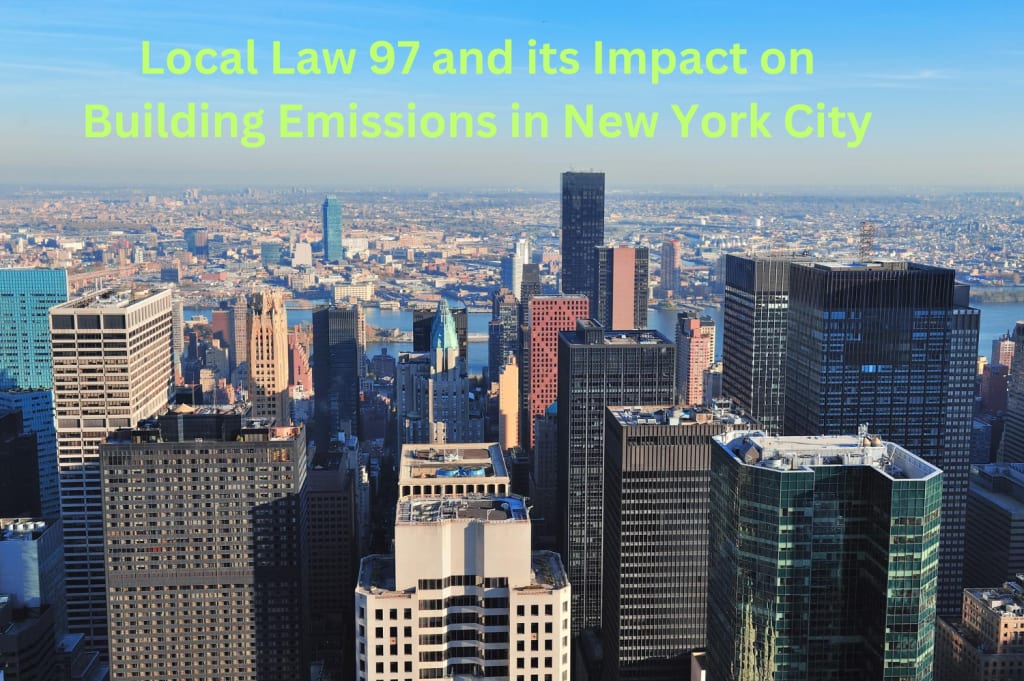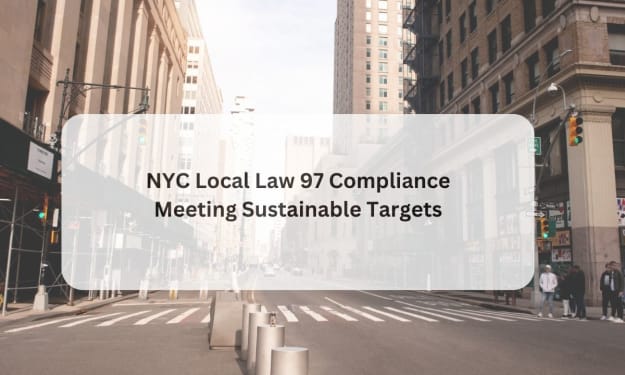Local Law 97 and its Impact on Building Emissions in New York City
Local Law 97

Local Law 97 is a new law passed in New York City that sets limits on greenhouse gas emissions for buildings larger than 25,000 square feet. The law requires that these buildings reduce their emissions by a certain amount over time, with the goal of reducing the city's overall emissions by 40% by 2030 and 80% by 2050.
The law applies to most buildings in New York City, including residential, commercial, and industrial buildings, but some types of buildings are exempt, such as houses of worship, low-income housing, and some industrial buildings.
Under the law, buildings are assigned a carbon limit based on their size and use, and they must meet this limit or face fines. The limits are calculated based on a building's energy use intensity (EUI), which is the amount of energy used per square foot of space.
To comply with the law, buildings can implement a variety of measures to reduce their emissions, such as upgrading their heating and cooling systems, improving insulation, and using renewable energy sources like solar and wind power. Buildings can also participate in carbon trading programs to offset their emissions.
The impact of Local Law 97 on building emissions in New York City is expected to be significant. Buildings are responsible for about 70% of the city's greenhouse gas emissions, and the law is expected to reduce emissions from the city's largest buildings by about 40%. However, the law has also faced criticism from some building owners and developers who argue that the costs of compliance are too high and that the law will lead to higher rents and building vacancies.
Overall, Local Law 97 represents a significant step forward for New York City in its efforts to combat climate change and reduce greenhouse gas emissions. It is also an example for other cities around the world to follow in their efforts to reduce the carbon footprint of their buildings.
What is Local Law 97?
Local Law 97 is a New York City law that was enacted in 2019 to address climate change and reduce greenhouse gas emissions from buildings. The law requires owners of large buildings, defined as those over 25,000 square feet, to meet specific greenhouse gas emissions limits starting in 2024. The emissions limits become more stringent over time, with the goal of reducing the city's greenhouse gas emissions by 40% by 2030 and 80% by 2050.
The law applies to most types of buildings, including residential, commercial, and industrial buildings. Some types of buildings are exempt from the law, such as houses of worship, low-income housing, and some industrial buildings.
To comply with the law, building owners can take a variety of measures to reduce greenhouse gas emissions, such as upgrading heating and cooling systems, improving insulation, and using renewable energy sources like solar and wind power. Buildings can also participate in carbon trading programs to offset their emissions.
Local Law 97 is one of the most ambitious climate change laws in the United States, and it is expected to have a significant impact on reducing greenhouse gas emissions in New York City. The law has also been recognized as a model for other cities to follow in their efforts to address climate change and reduce carbon emissions from buildings.
Why was Local Law 97 enacted?
Local Law 97 was enacted in New York City to address the significant contribution of buildings to greenhouse gas emissions and climate change. Buildings in New York City are responsible for approximately 70% of the city's total greenhouse gas emissions, which is a significant contributor to climate change.
The law was passed as part of the city's broader efforts to reduce its carbon footprint and meet the goals of the Paris Agreement on climate change. The Paris Agreement is an international agreement that aims to limit global warming to well below 2 degrees Celsius above pre-industrial levels and pursue efforts to limit the temperature increase to 1.5 degrees Celsius.
LL 97 sets specific emissions limits for large buildings in New York City and requires them to reduce their emissions over time. By reducing greenhouse gas emissions from buildings, the law aims to help the city meet its overall emissions reduction goals and contribute to global efforts to address climate change.
How does Local Law 97 work?
Local Law 97 works by setting specific emissions limits for large buildings in New York City and requiring them to reduce their greenhouse gas emissions over time. The emissions limits are based on a building's energy use intensity (EUI), which is the amount of energy used per square foot of space.
Starting in 2024, large buildings in New York City will be required to meet specific emissions limits based on their building type and occupancy. The emissions limits become more stringent over time, with the goal of reducing the city's greenhouse gas emissions by 40% by 2030 and 80% by 2050.
To comply with the law, building owners can take a variety of measures to reduce their greenhouse gas emissions, such as upgrading heating and cooling systems, improving insulation, and using renewable energy sources like solar and wind power. Buildings can also participate in carbon trading programs to offset their emissions.
The law allows for some flexibility in how building owners can meet the emissions limits, such as by using renewable energy certificates, carbon offsets, and trading emissions credits. Building owners can also earn additional compliance credits for measures such as installing green roofs, implementing energy storage systems, and using district energy systems.
Building owners are required to report their building's emissions annually, and non-compliance with the law can result in fines. The law also provides funding and resources to support building owners in meeting the emissions limits.
What is the impact of Local Law 97 on building emissions?
Local Law 97, also known as the Climate Mobilization Act, is a piece of legislation passed by the New York City Council in 2019. It sets ambitious targets for reducing greenhouse gas emissions from buildings in the city, which are responsible for about 70% of the city's total emissions.
Under Local Law 97, buildings over 25,000 square feet are required to meet strict emissions limits starting in 2024, with the limits becoming more stringent over time. The law applies to both new and existing buildings, and covers a range of building types, including residential, commercial, and industrial.
The impact of LL97 on building emissions is expected to be significant. According to estimates from the city, the law will reduce greenhouse gas emissions from buildings in New York City by 26% by 2030, and 40% by 2035. This will help the city to meet its overall emissions reduction targets, which aim to reduce emissions by 40% by 2030 and 80% by 2050.
To comply with the law, building owners will need to make significant investments in energy efficiency upgrades and renewable energy systems. This could include things like upgrading insulation, installing energy-efficient lighting and HVAC systems, and adding rooftop solar panels or other renewable energy sources. While these investments may be costly upfront, they are likely to result in significant long-term savings on energy bills, as well as improved indoor air quality and other benefits for building occupants.
Conclusion:
Local Law 97 is a crucial piece of legislation that aims to reduce greenhouse gas emissions from buildings in New York City. By setting emission limits and penalizing buildings that exceed them, the law incentivizes building owners to invest in energy-efficient upgrades and renewable energy sources. Its impact on building emissions is already being felt, and it is a critical step towards achieving the city’s larger goal of carbon neutrality by 2050.
About the Creator
The Cotocon Group
Sustainability Consulting Experts in NYC. Leading the Real Estate Industry in Reducing GHG Emissions & Increasing Property Value.
Website :- https://www.thecotocongroup.com






Comments
There are no comments for this story
Be the first to respond and start the conversation.